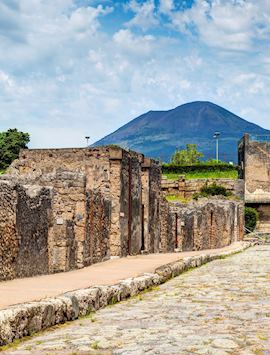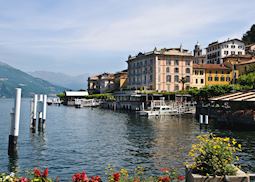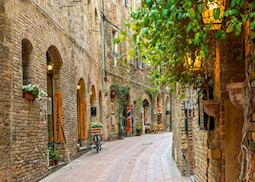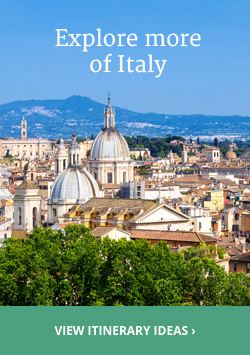The best time to visit Italy is during spring and fall, when temperatures are comfortable and there are fewer crowds. The scenery is vibrant, prices are lower, and the weather is ideal for exploring all the country has to offer.
Spring (March-May)
Temperatures start to warm up in spring, going from the late teens to mid-twenties, although it’s still advisable to wear layers in case of colder spells. It gets busier around Easter, with prices rising accordingly. Shops will close on Easter Sunday (Pasqua) and Easter Monday (Pasquetta).
Summer (June-August)
The summer months, July and August in particular, see higher temperatures – normally around 27°C, but they often reach over 31°C at the height of the day. Visitor numbers reach their peak at this time.
It’s worth noting that many Italians take the whole month of August off and escape the humidity, with lots of businesses closing during this time. However, this does mean the cities are much quieter, so you still have the chance to explore if you can cope with the heat.
Fall (September-November)
Temperatures cool down gradually, so September is still very pleasant, with an average of around 25°C. Expect crisp fall leaves and some sunnier days, but plan for wet weather too.
Some attractions introduce shorter winter hours from October, so be mindful of this when booking.
Winter (December-February)
Temperatures in the south remain mild in winter, although there is the occasional cold snap and rain is still possible.
However, northern Italy is normally wet and cold, with chilling winds blowing. It’s not unusual for snow to fall, especially in the mountains.
Holidays in Italy
- January 1: New Year (Capodanno)
- January 6: Epiphany (La Befana)
- Easter Sunday (Pasqua)
- Easter Monday (Pasquetta)
- April 25: Liberation Day
- May 1: Labor Day (Festa del Lavoro)
- June 2: Republic Day (Festa della Repubblica)
- August 15: Assumption of the Virgin (Ferragosto)
- November 1: All Saints’ Day
- December 8: The Immaculate Conception (L'Immacolata)
- December 25: Christmas Day (Natale)
- December 26: St Stephen’s Day (Santo Stefano)
Month-by-month guide for traveling in Italy
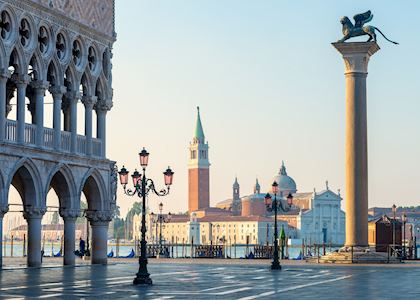
Visiting Italy in January
The milder Mediterranean winters make Italy’s cities an option for travel throughout January. Visitors are rewarded with quieter sights and far fewer tourists if they are willing to brave the cooler conditions.
Days can be cold and clear or wet and windy, with snow falling in mountain areas.
As it’s very much the off-season, some attractions will be closed or offer limited visiting hours, so it’s best to look this up in advance. Much of the Amalfi Coast, for instance, only gears up for visitors in the summer months, and most Tuscan properties are shut over the winter.
Events & Festivals
- The main celebration is a holiday called Epiphany, on January 6. It is the end of the Christmas season when Italians give each other presents and children hope a witch called La Befana will leave gifts in their stockings.
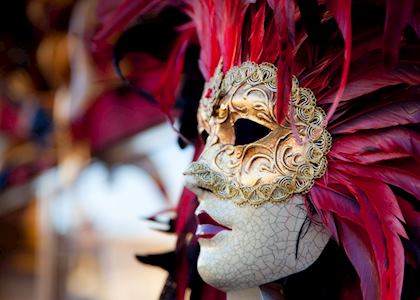
Visiting Italy in February
Prices tend to be cheaper in February, outside of carnival dates. Like January, visitors should be prepared for reduced opening hours and limited access to attractions in some areas, but you’ll benefit from much smaller crowds.
The amount of rain you can expect depends on the region you visit. There is less rainfall in north Italy in February but it increases in the south, although temperatures there are warmer. You may even be lucky enough to experience some sunny spells.
Events & Festivals
- In the south, in Sicily, the Valley of the Temples in Agrigento hosts an annual almond blossom festival with parades, shows and craft exhibits. The first of the almond blossom is celebrated as a welcome precursor to spring.
- Even the cold weather in the north can’t dissuade Italians from a party. The highlight of the month is Carnevale, celebrated across the country at the beginning of Lent with vibrant pageants, masquerades and confetti. The most well-known celebration is the Venice Carnival, a two-week spectacle of masks, fancy dress and spirited parties that see throngs of costumed people pack the famous St Mark’s Square.
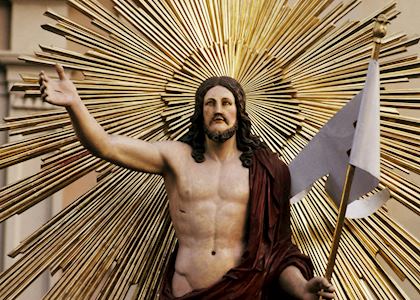
Visiting Italy in March
The weather in March can remain mixed and unpredictable, with spells of sunshine and rain. The beginning of the month can be colder, but as the official start of spring approaches on March 21, the country really starts to come alive and temperatures begin to rise.
It still rains frequently in the north, but you are still likely to see some sunny days. The chance of snowfall decreases and temperatures rise throughout the month.
The likelihood of sunshine in central Italy increases as the month goes on, while the weather in the south is mild and pleasant. March is a great time to explore regions like Puglia and Sicily.
Events & Festivals
- On March 9 devout Roman motorists have their cars and mopeds blessed at the church of Santa Francesca.
- Easter week in Rome is marked with a number of events led by the Pope, including a Palm Sunday Mass in St Peter’s Square and the Settimana Santa procession of the stations of the cross at the Colosseum, both of which attract large numbers of visitors.
- Most other towns and cities host their own Holy Week celebrations with various processions and services.
- The Rome Marathon is held on the third Sunday of March.
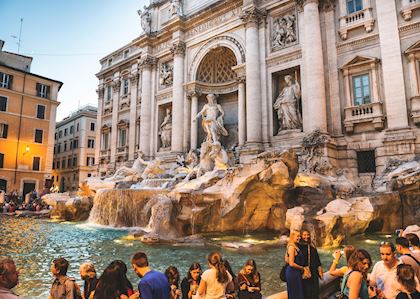
Visiting Italy in April
April is a wonderful time to visit Italy. Temperatures are pleasant and comfortable, with wildflowers blooming across the countryside. Everything is now open for business after the winter months, and regular ferries and hiking trails along the Cinque Terre and Ligurian Coast start to pick up business.
There can be the odd shower, and temperatures are likely to be cooler and more changeable in the north, however, this shouldn’t dissuade you. Chances are you will need to pack both sunglasses and a rain jacket, no matter where you decide to go.
Events & Festivals
- Easter week in Rome is marked with a number of events led by the Pope, including a Palm Sunday Mass in St Peter’s Square and the Settimana Santa procession of the stations of the cross at the Colosseum, both of which attract large numbers of visitors.
- Venice enjoys the Festa di San Marco on April 25. Men offer a single rosebud to the woman they love in celebration of the city’s patron saint.
- Most other towns and cities host their own Holy Week celebrations with various processions and services.
- Liberation Day, a national holiday, is also on April 25. It commemorates the Allied overthrow of the Nazis and the end of Mussolini’s rule.
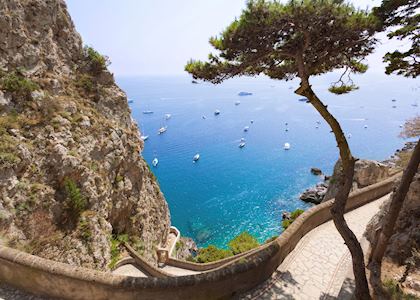
Visiting Italy in May
Known as the month of the rose, May is a beautiful time to experience Italy. It’s warm but not too hot, and still early enough to avoid the crowds of summer visitors.
Gardens across the country are at their peak. Whether you’re visiting historical cities like Rome or Florence or exploring the countryside, it’s a fantastic time to be outside.
Temperatures are reliably pleasant at this time of year. There may be the odd shower in the north and central regions, but otherwise, it’s sunny during the day, with lovely blue skies.
Events & Festivals
- Assisi celebrates Calendimaggio, a medieval and renaissance festival with entertainment like concerts, theater and dance shows, and processions through the beautifully decorated town.
- The patron saint of Abruzzo, Saint Dominic, is honored with a parade where his statue is carried around the town, covered in live snakes. This is known as Festa dei Serpari.
- In Venice, the Festa della Sensa, celebrated on Ascension Day, marks Venice’s ‘Wedding to the Sea’. Boats abound with a huge regatta and traditional rowing races, culminating with a symbolic union where the mayor tosses a gold ring into the water.
- There are a lot of events in the month of May, as the Italians celebrate spring with food, wine and flower festivals. Florence’s Iris Garden opens to the public for just a few weeks, the only time in the year that you can walk through it.
- For keen cyclists this is the start of the Giro d’Italia bicycle race — the Italian equivalent of the Tour de France.
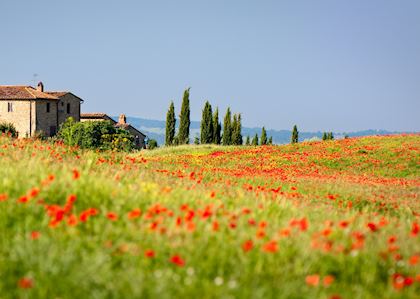
Visiting Italy in June
Summer has officially begun. High temperatures in June attract visitors to Italy’s beaches and swimming pools, and peak season really gets underway. Visitors can enjoy wonderful open-air performances in cities such as Rome and Verona, while sun-seekers can relax.
Rain is unlikely to fall, so June is the time when visitors start to flock to Italy’s many picturesque destinations: historical cities, quaint villages, and beautiful beaches.
Events & Festivals
- June is a particularly good time to visit the Italian Lakes region — summer is in full swing but the crowds haven’t arrived in force yet. The Alpine slopes turn vibrant green, the sky and water are both deep blue, and the weather is warm enough to enjoy kayaking or boating. This is also when the gardens at Isola Bella reach their peak. Read more about the Italian Lakes
- La Festa della Repubblica on June 2 is a national holiday, celebrating the foundation of the modern republic of Italy.
- Luminara di San Ranieri is celebrated on June 16 in Pisa, with thousands of people lining windows and doorways along the River Arno. It culminates in a dramatic firework display.
- Republic Day on June 2 is a national holiday, celebrating the foundation of the modern republic of Italy.
- Toward the end of June, the summer opera season at the amphitheater in Verona begins along with the Estate Romana program of events in Rome.
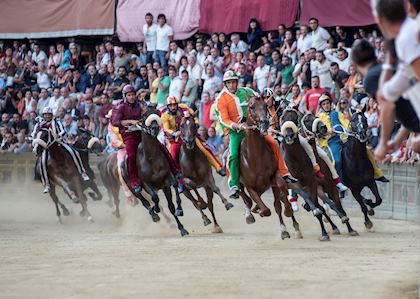
Visiting Italy in July
July sees increased summer temperatures and high visitor numbers, as pupils have a break from school and families take the opportunity for a vacation.
Some travelers may find the south too hot during peak season, but the north and central regions are usually pleasantly balmy, although it’s advisable to stay somewhere with air conditioning.
July is one of the most expensive times to visit Italy, so travel during this month needs to be planned well in advance.
Events & Festivals
- The first Palio horse race occurs in Piazza del Campo in Siena on July 2. It is a historic battle between the city’s contrade (districts) as they compete for glory.
- Madonna della Bruna is a festival that takes place in Matera on July 2. A procession is held, with a giant float of the Madonna Bruna as the centerpiece. This float is dismantled and burned afterwards, followed by a fireworks display.
- Open-air performances and concerts take place in areas like Ravello, on the Amalfi Coast, and in Sicily’s Greek theaters in Syracuse and Taormina.
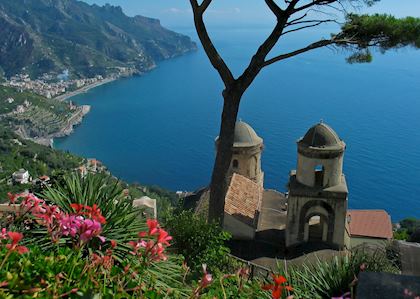
Visiting Italy in August
The hot, dry days of August draw in the crowds. The cities can be particularly stifling at this time of year and many locals depart en masse for the beaches, mountains or countryside.
Not everything will be open — but not everything will be closed either, and in some cities, you’ll have more space to explore because the residents aren’t there. Take shelter during the hottest part of the day by using the time to explore museums and galleries.
August is one of the most expensive times to visit Italy, so travel during this month needs to be planned well in advance.
Events & Festivals
- One of the best festivals in the Marche region is La Quintana, on the first weekend of August. A large, 15th century-style parade takes place, followed by a jousting tournament.
- Open-air performances and concerts take place in areas like Ravello, on the Amalfi Coast, and in Sicily’s Greek theaters in Syracuse and Taormina.
- The second Palio horse race occurs in Piazza del Campo in Siena on August 16. It is a historic battle between the city’s contrade (districts) as they compete for glory.
- Venice International Film Festival starts at the end of August and continues into September.

Visiting Italy in September
By September, summer temperatures have usually peaked and while the days remain hot, the nights tend to be cooler and more comfortable.
Italians are now back at work or have returned to school, emptying the beaches to less crowded levels, although September is still a popular month with travelers.
The north is much cooler at this time of year — but not cold. You may see the odd rain shower in the north and central regions, but it’s still dry in the south, with pleasant weather throughout the day.
Events & Festivals
- September burnishes the Amalfi Coast with warm, harvest-gold sunshine, even as the summer throngs empty out of the region. The days are still balmy enough that you can soak up the sun on the beaches with fewer crowds and the evenings are comfortable for dining out at the glamorous restaurants and cafes. Read more about the Amalfi Coast
- MITO Musical Festival is on throughout the month in Milan and Turin.
- The Regata Storica takes place in Venice on the first Sunday in September, with gondola races, gondoliers in traditional dress and plenty of vibrant waterborne pageantry.
- Venice International Film Festival starts at the end of August and continues into September.
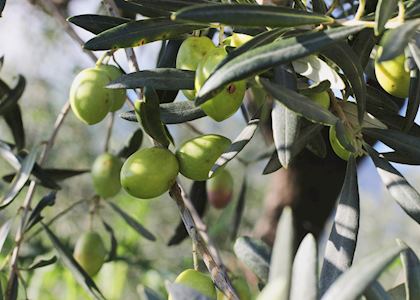
Visiting Italy in October
Visitors in October can enjoy the last of the summer heat, making it a popular time for exploring the cities.
Events & Festivals
- Though the exact timing varies from year to year, early October is often when you can witness the grape harvest — called vendemmia — in Tuscany. This makes it an excellent month for visiting one of the region’s many agriturismos, where can you get a front-row seat to the region’s agricultural practices. Read more about Tuscany
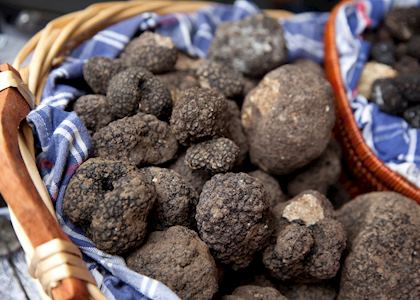
Visiting Italy in November
The last month of fall sees temperatures cool, although travel is still very much an option. You may be faced with shorter days and rainier weather, but there are very few tourists and it’s a great time to explore indoor sites like museums, galleries, and religious buildings.
It gets much colder in the north in particular, especially at night, so be sure to wrap up warm. Central Italy is slightly warmer, although it’s still brisk. As always, temperatures are highest in the south and you may even see a little sunshine, but you should still be prepared for rain.
Events & Festivals
- All Saints Day is a national holiday celebrated on November 1. The following day is known as All Souls Day — the Italian equivalent of the Mexican Day of the Dead.
- November is truffle season, complete with fairs, markets and gastronomic treats across northern Italy.
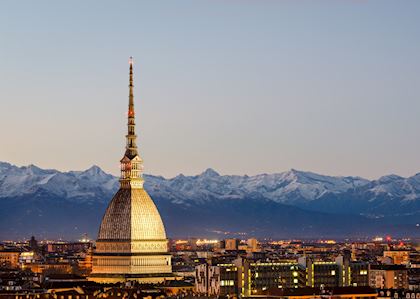
Visiting Italy in December
Similar to January, the milder Mediterranean winters make much of Italy still an option for travel during the colder winter months. You’re rewarded with quieter cities and sights, though you’ll have to brave cooler conditions.
As it is very much the off-season, you’ll find many hotels outside the major cities are closed and hiking trails in the main areas like the Cinque Terre don’t open until Easter.
The exception is in Italy’s ski resorts, where skiing season is in full swing in the Alps and the Dolomites. Snow is expected in these areas, but it may even fall in places that sit close to sea level.
Events & Festivals
- The city of Paternò celebrates Saint Barbara Day with a parade on the slopes of Mount Etna, thanking the patron saint for protecting the fire brigade and preventing the volcano from erupting.
Italy Climate Guide
| Destination | Jan | Feb | Mar | Apr | May | Jun | Jul | Aug | Sep | Oct | Nov | Dec |
|---|---|---|---|---|---|---|---|---|---|---|---|---|
| Florence | 10°C 60mm | 12°C 63mm | 15°C 63mm | 18°C 86mm | 23°C 70mm | 27°C 57mm | 31°C 36mm | 31°C 56mm | 26°C 79mm | 20°C 104mm | 14°C 113mm | 11°C 81mm |
| Lake Como | 3°C 64mm | 5°C 60mm | 9°C 85mm | 13°C 121mm | 17°C 165mm | 21°C 151mm | 24°C 127mm | 22°C 156mm | 19°C 132mm | 14°C 124mm | 8°C 108mm | 5°C 55mm |
| Milan | 5°C 55mm | 8°C 62mm | 13°C 79mm | 18°C 92mm | 23°C 94mm | 27°C 97mm | 29°C 67mm | 28°C 90mm | 24°C 79mm | 18°C 118mm | 11°C 110mm | 6°C 71mm |
| Naples | 12°C 103mm | 13°C 85mm | 15°C 76mm | 18°C 71mm | 23°C 47mm | 26°C 31mm | 29°C 22mm | 29°C 38mm | 26°C 74mm | 22°C 118mm | 17°C 147mm | 13°C 112mm |
| Palermo | 13°C 83mm | 13°C 67mm | 15°C 57mm | 18°C 47mm | 21°C 22mm | 25°C 11mm | 28°C 5mm | 28°C 17mm | 26°C 37mm | 22°C 84mm | 18°C 82mm | 14°C 88mm |
| Pompeii | 12°C 92mm | 12°C 76mm | 14°C 69mm | 18°C 60mm | 22°C 42mm | 26°C 27mm | 29°C 24mm | 29°C 39mm | 26°C 64mm | 21°C 100mm | 16°C 133mm | 13°C 107mm |
| Venice | 6°C 50mm | 8°C 53mm | 12°C 62mm | 17°C 74mm | 21°C 73mm | 25°C 78mm | 27°C 63mm | 27°C 77mm | 24°C 69mm | 19°C 77mm | 12°C 93mm | 7°C 64mm |
| Verona | 6°C 41mm | 9°C 42mm | 13°C 48mm | 18°C 72mm | 22°C 79mm | 26°C 85mm | 29°C 60mm | 28°C 78mm | 24°C 67mm | 18°C 80mm | 12°C 80mm | 7°C 56mm |
Why travel with Audley?
- 100% tailor-made tours
- Fully protected travel
- Established for over 25 years
- 98% of our clients would recommend us
Travel advice
Practical tips for traveling to Italy, from social protocols to guidance on money matters, with a link to the latest Government of Canada travel advice.

Request our brochure
Covering all seven continents, The World Your Way shows you how you can see the world with us. It features trip ideas from our specialists alongside hand-picked stays and experiences, and introduces our approach to creating meaningful travel experiences.
Trip ideas and travel guides for exploring Italy
-
![St Mark's Square, Venice]()
-
![Street overlooking Vesuvius, Pompeii]()
-
The Italian Lakes ![Waterfront, Lake Como]()
The Italian Lakes
The Italian Lakes
Read this guide -
Hidden highlights of Tuscany ![Alley in old town San Gimignano, Tuscany]()
Hidden highlights of Tuscany
Hidden highlights of Tuscany
Read this guide




